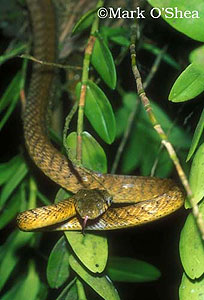Check out the brown treesnake.
Distribution: Eastern Indonesia, Papua New Guinea, Solomons and northeastern Australia, introduced to Guam.
Habitat: Most habitats.
Diet: Frogs, lizards, snakes, mammals and birds.
Max.length: 1.5-2.0m SVL (2.0m-2.3m TL).
Reproductive strategy: Oviparous with clutches of 3-11 eggs.
It is well known that the brown catsnake or brown treesnake has been introduced to Guam and caused an ecological catastrophe, the subject of an OBA film entitled “Snake Invasion”, but in New Guinea and the Solomons the snake is at equilibrium with prey, predators and the environment. The brown treesnake is primarily nocturnal with the vertically elliptical cat-like pupils typical of such snake worldwide. It has a large mouth and rear-fangs, and will bite with little provocation and bites have caused localized pain and swelling and more serious problems with babies. In New Guinea there are many more dangerous snakes that this and it does not feature highly in snakebite statistics. Highly agile and an excellent climber, the brown treesnake may be found almost anywhere and will feed on almost anything it can fit in its mouth.

Mark O'Shea
Brown treesnakes will eat almost anything it can fit into their mouths.
Sources for more information (excluding most Guam references):
Greene H.W. 1989 Ecological, evolutionary and conservation implications of feeding biology in Old World cat snakes, genus Boiga (Colubridae). Proceedings of the California Academy of Sciences. 46(8):193-207.
Johnson C.R. 1975 Thermoregulation in the Papuan-New Guinean boid and colubrid snakes, Candoia carinata, Candoia aspera and Boiga irregularis. Zoological Journal of Linnean Society. 56:283-290.
McCoy M. 1980 Reptiles of the Solomon Islands. Wau Ecology Handbook No.7. vi+80.
O’Shea M. 1996 A Guide to the Snakes of Papua New Guinea. Independent Pub. xii+239.
Rodda G.H., Y.Sawai, D.Chiszar & H.Tanaka (eds.) 1999 Problem Snake Management: The habu and the brown treesnake. Comstock Cornell. xix+534.


